
15 minute read
MAINTENANCE SAFETY
from Bobcat 653 Foot Pedal & Hand Control Loader Operation & Maintenance Manual 6900444 - PDF DOWNLOAD
Instructions are necessary before operating or servicing machine. Read Operation & Maintenance Manual, Handbook and signs (decals) on machine. Follow warnings and instructions in the manuals when making repairs, adjustments or servicing. Check for correct function after adjustments, repairs or service. Failure to follow instructions can cause injury or death.
Safety Alert Symbol:This symbol is used for important safety messages. When you see this symbol, follow the safety message to avoid personal injury or death.
Correct
Correct
Correct
Never service the Bobcat® Skid Steer Loader without instructions.
Use the correct procedure to lift or lower operator cab with lift arms down.
Cleaning and maintenance are required daily.
Wrong Wrong Wrong
Have good ventilation when welding or grinding painted parts. Wear dust mask when grinding painted parts. Toxic dust and gas can be produced.
Wrong
Stop, cool and clean engine of flammable materials before checking fluids.
Never service or adjust loader with the engine running unless instructed to do so in the manual. Avoid contact with leaking hydraulic fluid or diesel fuel under pressure. It can penetrate the skin or eyes.
Never fill fuel tank with engine running, while smoking or when near open flame.
Vent exhaust to outside when engine must be run for service. Avoid exhaust fume leaks which can kill without warning. Exhaust system must be tightly sealed.
Never work on loader with lift arms up unless lift arms are held by a lift arm support device. Never modify equipment or add attachments not approved by Melroe Company.
Wrong Wrong
Keep body, jewelry and clothing away from moving parts, electrical contacts, hot parts and exhaust.
Wear eye protection to guard from battery acid, compressed springs, fluids under pressure and flying debris when engines are running or tools are used. Use eye protection approved for type of welding. Keep rear door closed except for service. Close and latch door before operating the loader.
Lead–acid batteries produce flammable and explosive gases. Keep arcs, sparks, flames and lighted tobacco away from batteries.
Batteries contain acid which burns eyes or skin on contact. Wear protective clothing. If acid contacts body, flush well with water. For eye contact flush well and get immediate medical attention.
Maintenance procedures which are given in the Operation & Maintenance Manual can be performed by the owner/operator without any specific technical training. Maintenance procedures which arenot in this manual must be performed ONLY BY QUALIFIED BOBCAT SERVICE PERSONNEL. Always use genuine Bobcat replacement parts.
Service Schedule
Maintenance work must be done at regular intervals. Failure to do so will result in excessivewear and early failures. The service schedule is a guide for correct maintenance of the Bobcat loader.
Instructions are necessary before operating or servicing machine. Read Operation & Maintenance Manual, Handbook and signs (decals) on machine. Follow warnings and instructions in the manuals when making repairs, adjustments or servicing. Check for correct function after adjustments, repairs or service. Failure to follow instructions can cause injury or death.
Engine Oil Check the oil level and add oil as needed.
Air Cleaner Check condition indicator. Service only when required.
Engine Cooling SystemClean debris from oil cooler, radiator and grill. Check coolant level cold in recovery tank. Fill with recommended coolant as needed.
Lift Arms, Cyl., Bob–TachLubricate with multi–purpose lithium based grease (12places).
Pivot Pins and Wedges
Engine Air System Check for damaged components.
Tires Check for damaged tires and correct air pressure.
Seat Belt, Seat Bar and Check the condition of seat belt. Check the seat bar and pedal Pedal Interlocks or Handinterlocks or hand control interlocks for correct operation. Clean Control Interlocks dirt and debris from moving parts.
Bobcat Interlock Control Check BICS functions. Clean dirt, debris or objects from under System (BICS™) or behind seat as required.
Safety Signs and SafetyCheck for damaged signs (decals) and safety treads. Replace Treads any signs or safety treads that are damaged or worn.
Operator Cab Check the fastening bolts, washers and nuts. Check the condition of cab.
Fuel Filter Remove the trapped water.
Hyd. Fluid, Hoses & Check fluid level and add as needed. Check for damage Tubelines and leaks. Repair and replace as needed.
Final Drive Trans.(Chaincase) Check oil level.
BatteryCheck cables connections and electrolyte level. Add distilled water as needed.
Foot Pedals or Hand Check for correct operation. Repair or adjust as needed. Controls & Steering
Wheel Nuts Check for loose wheel nuts and tighten to 105–115 ft.–lbs. (142–156 Nm) torque.
Parking Brake Check operation and correct as needed.
Alternator Belt Check tension and adjust as needed.
Engine Oil & Filter Replace oil and filter.
Spark Arrestor MufflerClean the spark chamber.
Engine/Hydro. Drive BeltCheck for wear or damage. Adjust as needed.
Fuel Filter Replace filter element.
Steering Shaft Grease two fittings.
Hyd./Hydro. Filter Replace the filter element.
Hydraulic Reservoir Replace the reservoir breather cap.
Breather Cap
Fan Drive Gearbox Check gear lubrication level.
Final Drive Trans.(Chaincase) Replace the oil.
Hydraulic Reservoir Replace the fluid.
Case Drain Filters Replace the case drain filters (2).
Bobcat Interlock ControlCheck lift arm by–pass control.
System (BICSTM)
Engine Timing Belt Replace the timing belt. Or every 12 months.
Check wheel nut torque every 8 hours for the first 24 hours. Replace break–in filter and engine oil at 50 hours on a new loader; 100 hours thereafter.
*Inspect the new belt after first 50 hours.
Also replace hydraulic/hydrostatic filter element when the transmission warning light comes ON.
The Bobcat loader has an operator cab (ROPS and FOPS) as standard equipment to protect the operator from rollover and falling objects. Check with your dealer if the operator cab has been damaged.
ROPS/FOPS – Roll Over Protective Structure per SAE J1040 and ISO 3471, and Falling Object Protective Structure per SAE J1043 and ISO 3449, Level l. Level ll is available.
Level l – Protection from falling bricks, small concrete blocks and hand tools encountered in operations such as highway maintenance, landscaping, and other construction site services.
Level ll – Protection from falling trees, rocks; for machines involved in site clearing, overhead demolition or forestry.
Never modify operator cab by welding, grinding, drilling holes or adding attachments unless instructed to do so by Melroe Company. Changes to the cab can cause loss of operator protection from rollover and falling objects, and result in injury or death.
W–2069–1285
Raising The Operator Cab
Stop the loader on a level surface. Lower the lift arms. If the lift arms must be up while raising the operator cab, install the lift arm support device. (See LIFT ARM SUPPORT DEVICE Page 46.)
Loosen the nut (both sides) at the front corner of the operator cab [A]
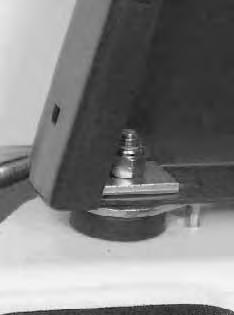
Remove the nut and plate (both sides) [A]
With Hand Controls Only: Disconnect the control linkage joint from the bottom hole (work position) and move to the TOP hole on the control handle (both sides) [B].Both control handles must be in the vertical position so there will be no cab interference with the steering levers when the operator cab is raised or lowered.
Lift on the grab handle and bottom of the operator cab slowly until the cab latching mechanism engages and the cab is all the way up [C]

Use care when raising or lowering the operator cab to prevent damaging the shaft of the lift arm by–pass control.
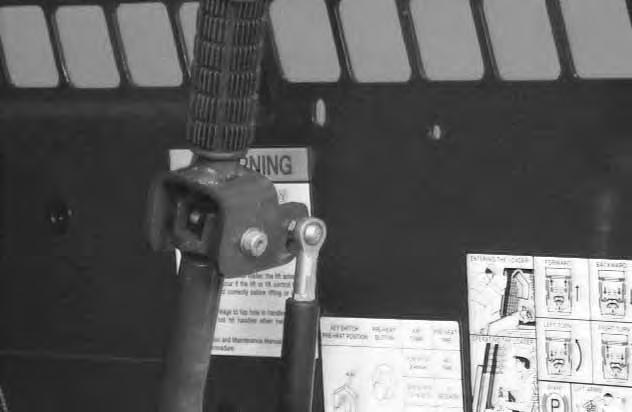
I–2070–0596
Before the cab or the lift arms are raised for service, jackstands must be put under the rear corners of the frame. Failure to use jackstands may allow the machine to tip backward causing injury or death.
W–2014–1285
OPERATOR CAB (Cont’d)
Lowering The Operator Cab
NOTE:Make sure the seat bar is fully raised or lowered when lowering the cab. Always use the grab handles to lower the cab.
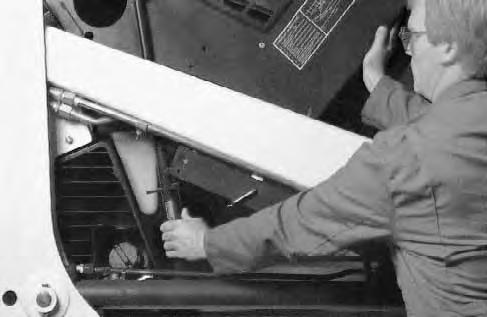
Pull down on the bottom of the operator cab until it stops at the latching mechanism. Release the latching mechanism and pull the cab all the way down [A]
Install the plate and nut (both sides) [B]
Tighten the nuts to 40–50 ft.–lbs. (54–68 Nm) torque.
With Hand Controls Only: Move the control linkage from the top hole to the BOTTOM hole (work position) on the control handle (both sides) [C]


Use care when raising or lowering the operator cab to prevent damaging the shaft of the lift arm by–pass control.
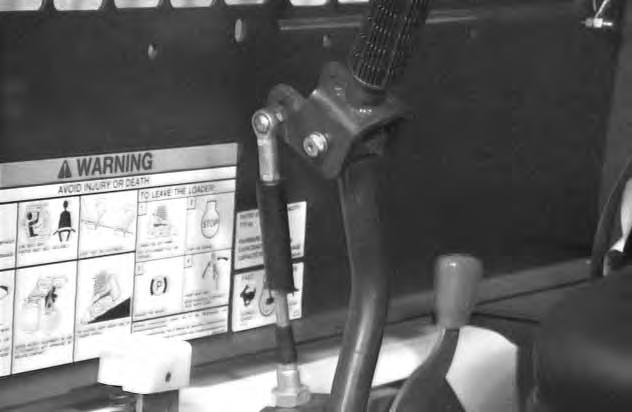
OPERATOR CAB (Cont’d)
Emergency Exit
The front opening on the operator cab and rear window provide exits.
Rear Window
To exit through the rear window, use the following procedure:
Pull on the tag on the top of the rear window to remove the rubber cord [A]


Push the rear window out of the rear of the operator cab. Exit through the rear of the operator cab [B].
Front Door
NOTE:When an Operator Cab Enclosure Kit is installed, the window of the front door can be used as an emergency exit [C].

Pull the plastic loop at the top of the window in the front door to remove the rubber cord [C]
Push the window out with your foot [D]
Exit through the front door.

SEAT BAR RESTRAINT SYSTEM (FOOT PEDALS)
The seat bar restraint system has a pivoting, spring assist * seat bar with arm rests and has spring loaded interlocks for the lift and tilt control pedals.
The operator controls the use of the seat bar. The seat bar in the down position helps to keep the operator in the seat.
The interlocks require the operator to lower the seat bar in order to operate the foot pedal controls.
When the seat bar is up, the lift and tilt pedals are locked when returned to the NEUTRAL POSITION.
*Early models have a gas spring.
AVOID
Injury Or Death
The Seat Bar System must lock the lift and tilt foot pedals or hand controls in neutral when the Seat Bar is up. Service the system if controls do not lock correctly.

Inspecting The Seat Bar
Sit in the seat and fasten the seat belt. Engage the parking brake. Pull the seat bar all the way down. Start the engine. Operate each foot pedal to check both the lift and tilt functions. Raise the lift arms until the bucket is about 2 feet (600 mm) off the ground.
Raise the seat bar. Try to move each foot pedal. Pedals must be firmly locked in neutral position. There must be no motion of the lift arms or tilt (bucket) when the pedals are pushed.
Pull the seat bar down, lower the lift arms. Operate the lift pedals. While the lift arms are going up, raise the seat bar and the lift arms should stop.
Lower the seat bar, lower the lift arms and place the bucket flat on the ground. Stop the engine. Raise the seat bar and operate the foot pedals to be sure that the pedals are firmly locked in the neutral position. Unbuckle the seat belt.
Maintaining The Seat Bar
See the SERVICE SCHEDULE Page 37 and on the loader for correct service interval.
Clean any debris or dirt from the moving parts [A] & [B]. Inspect the linkage bolts and nuts for tightness. The correct torque is 25–28 ft.–lbs. (34–38 Nm).
If the seat bar system does not function correctly, check for free movement of each linkage part. Check for excessive wear. Adjust pedal control linkage. Replace parts that are worn or damaged. Use only genuine Bobcat replacement parts.
Avoid Injury Or Death
Never operate loader without pedal lock shield 6705474 on both interlocks. Shields prevent foot from unlocking interlocks when leaving loader seat.
W–2162–1194

SEAT BAR RESTRAINT SYSTEM (HAND CONTROLS)
The seat bar restraint system has a pivoting spring assist * seat bar with arm rests and has spring loaded interlocks for the lift and tilt control functions.

The operator controls the use of the seat bar. The seat bar in the down position helps to keep the operator in the seat.
The interlocks require the operator to lower the seat bar in order to operate the hand controls.
When the seat bar is up, the lift and tilt control functions are locked when returned to the NEUTRAL POSITION.
*Early models have a gas spring.
Inspecting The Seat Bar
Sit in the seat and fasten the seat belt. Engage the parking brake. Pull the seat bar all the way down. Start the engine. Operate each hand control to check both the lift and tilt functions. Raise the lift arms until the bucket is about 2 feet (600 mm) off the ground.
Raise the seat bar. Try to move each hand control. Pedals must be firmly locked in neutral position. There must be no motion of the lift arms ortilt (bucket) when the controls are pushed.
Pull the seat bar down, lower the lift arms. Operate the lift left and control to raise the lift arms. While the lift arms are going up, raise the seat bar and the lift arms should stop.
Lower the seat bar, lower the lift arms and place the bucket flat on the ground. Stop the engine. Raise the seat bar and operate the hand controls to be sure that the controls are firmly locked in the neutral position. Unbuckle the seat belt.
Never operate loader without interlock shield 6705474 on both interlocks. Shields prevent foot from unlocking interlocks when leaving loader seat.

Avoid Injury Or Death
The Seat Bar System must lock the lift and tilt foot pedals or hand controls in neutral when the Seat Bar is up. Service the system if controls do not lock correctly.
W–2263–0597
Maintaining The Seat Bar
See the SERVICE SCHEDULE Page 37 for correct service interval.
Clean any debris or dirt from the moving parts [A] & [B] Inspect the linkage bolts and nuts for tightness. The correct torque is 25–28 ft.–lbs. (34–38 Nm).
If the seat bar system does not function correctly, check for free movement of each linkage part. Check for excessive wear. Adjust pedal control linkage. Replace parts that are worn or damaged. Use only genuine Bobcat replacement parts.
BOBCAT INTERLOCK CONTROL SYSTEM (BICS™)
Inspecting the BICS™ Controller (Engine STOPPED – Key ON)
1.Sit in the operator’s seat. Turn key ON, lower the seat bar and disengage the parking brake. All five BICS Controller lights should be ON (Items 1, 2, 3, 4 & 5) [A].
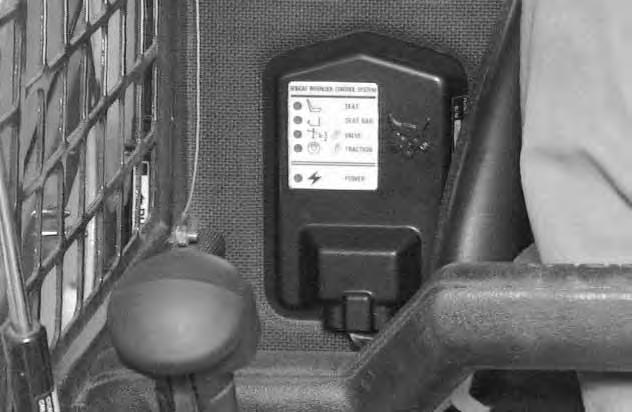
2.Engage the parking brake and raise the seat bar fully. Seat bar light (Item 2) [A], valve light (Item 3) [A] and traction light (Item 4) [A] should be OFF.
3.Raise up slightly off the seat. Seat light (Item 1) [A] should be OFF.
NOTE:Record what lights are blinking (if any) and number of blinks. Refer to Page 73.
4.Exit the loader and press traction lock override button. Traction light (Item 4) [A] should be ON. Press override button again and traction light (Item 4) [A] should be OFF.
Later Model Loaders Only (See Page v.) Inspecting Deactivation of the Auxiliary Hydraulics System (Engine STOPPED – Key ON)
5.Sit in the operator’s seat. Lower the seat bar. Press the auxiliary hydraulics mode switch. The mode switch light will come ON. Raise the seat bar. The light should be OFF.
Inspecting the Seat and Seat Bar Sensors (Engine RUNNING)
6.Sit in the operator’s seat. Lower the seat bar. Engage the parking brake. Fasten the seat belt.
7.Start the engine and operate at low idle. While raising the lift arms, raise the seat bar fully. The lift arms should stop. Repeat using the tilt function.
Inspecting the Traction Lock (Engine RUNNING)
8.Fasten the seat belt, disengage the parking brake, and raise the seat bar fully. Move the steering levers slowly forward and backward. The traction lock should be engaged. Lower the seat bar.
9.Engage the parking brake pedal and move the steering levers slowly forward and backward. The traction lock should be engaged.
Inspecting the Lift Arm By–Pass Control
10. Raise the lift arms six feet (2 m) off the ground. Stop the engine.
Later Model Loaders (See Page v.) Turn the lift arm by–pass control knob clockwise 1/4 turn. Then pull up and hold the lift arm by–pass control knob until the lift arms slowly lower.
Early Model Loaders (See Page v.) With the operator in the seat, seat belt fastened and theseat bar fully lowered, pull and hold the by–pass control knob up. Push the top (toe) of the left (lift) pedal (or move the left hand control toward the operator). The lift arms will slowly lower.
BOBCAT INTERLOCK CONTROL SYSTEM (BICS™) (Cont’d)
Maintenance
Clean any debris, dirt or objects from under or behind the operator seat [A] & [B]. The rear of the seat must move up and down.
Inspect both seat rail covers [B] for wear or damage. Replace if necessary.
Clearance is necessary under the seat spring (Item 1)[B] and the seat, to allow the seat to move upand down freely. With adequate clearance, the seat sensor will be allowed to function correctly.
Inspect seat bar pivot area for tightness of linkage bolts. Replace parts that are damaged. Use only genuine Bobcat replacement parts.
BSeat Sensor
Seat Rail Cover
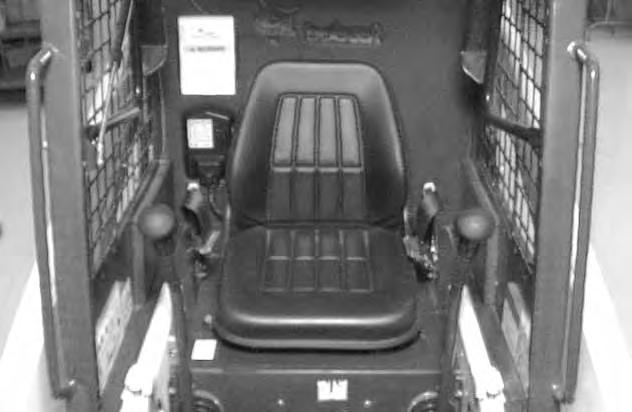
AClean area behind and under seat.
Operator Seat Seat Spring 1
The Bobcat Interlock Control System (BICS) must deactivate the lift, tilt and traction drive functions. If it does not, contact your dealer for service. DO NOT modify the system.
Pivot Pins
All lift arm and cylinder pivots have a large pin held in position with a retainer bolt and lock nut (Item 1) [A]
Check that the lock nuts are tightened to 18–20 ft.–lbs. (24–27 Nm) torque.
Tire Maintenance
Wheel Nuts
See the SERVICE SCHEDULE Page 37 for the service interval to check the wheel nuts. The correct torque is 105–115 ft.–lbs. (142–156 Nm) torque [B]
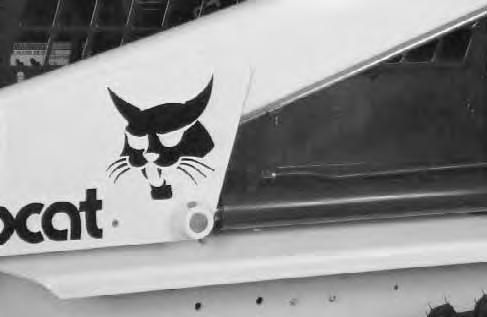
Tire Rotation
Check the tires regularly for wear, damage and pressure. (See SPECIFICATIONS Page 85 for the correct tire pressure.)
Rear tires usually wear faster than front tires. To keep tire wear even, move the front tires to the rear and rear tires to the front [C]
It is important to keep the same size tires on each side of the loader. If different sizes are used, each tire will be turning at a different rate and cause excessive wear. The tread bars of all the tires must face the same direction.
Recommended tire pressure must be maintained to avoid excessive tire wear and loss of stability and handling capability. Check for the correct pressure before operating the loader.
Tire Mounting
Tires are to be repaired only by an authorized person using the proper procedures and safety equipment. Tires and rims must always be checked for correct size before mounting. Check rim and tire bead for damage.
The rim flange must be cleaned and free of rust. The tire bead and rim flange must be lubricated with a rubber lubricant before mounting the tire, avoid excessive pressure which can rupture the tire and cause serious injury or death. During inflation of the tire, check the tire pressure frequently to avoid over inflation.

Do not inflate tires above specified pressure. Failure to use correct tire mounting procedure can cause an explosion which can result in injury or death.
W–2078–1285
I–2057–0794
Never work on a machine with the lift arms up unless the lift arms are secured by a lift arm support device. Failure to use an approved lift arm support device can allow the lift arms or attachment to fall and cause injury or death.

W–2059–0991
Engaging The Lift Arm Support Device
Maintenance and service work can be done with the lift arms lowered. If the lift arms are raised for service, use the following procedure:
Put jackstands under the rear corners of the loader.
Disconnect the spring from the lift arm support device retaining pin (Item 1) [A], hold onto the lift arm support device (Item 2) [A] and remove the retaining pin.
Lower the lift arm support device on top of the lift cylinder. Hook the free end of the spring (Item 1)[B] to the lift arm support device so there will be no interference with the support device engagement.
With the operator in the seat, seat belt fastened and seat bar lowered, start the engine.
Raise the lift arms, until the lift arm support device drops onto the lift cylinder rod [C].
Lower the lift arms slowly until the support device is held between the lift arm and the lift cylinder. Stop the engine. Raise the seat bar and move pedals (or hand controls) until both lock.
Install pin (Item 1) [C] into the rear of the lift arm support device below the cylinder rod.

Service lift arm support device if damaged or if parts are missing. Using a damaged lift arm support or with missing parts can cause lift arms to drop causing injury or death.
W–2271–1197

LIFT ARM SUPPORT DEVICE (Cont’d)
Disengaging The Lift Arm Support Device
Remove the pin from the lift arm support device.
Connect the spring (Item 1) [A] from the lift arm support device to the bracket below the lift arms.
With the operator in the seat, seat belt fastened and seat bar lowered, start the engine.
Raise the lift arms a small amount and the spring will lift the support device off the lift cylinder rod. Lower the lift arms. Stop the engine.
Raise the seat bar and move pedals (or hand controls) until both lock.
Disconnect the spring from the bracket.
Raise the support device into storage position and insert pin through lift arm support device and bracket. (See Page 46, Item 1 [A].)

Connect spring to pin. (See Page 46, [A].)
Remove the jackstands.
BOB–TACH
Check for free movement of wedges and Bob–Tach levers.
The wedges (Item 1) [B] must extend far enough to engage the holes in the attachment.
Bob–Tach wedges must extend through the holes in attachment. Levers must be fully down and locked. Failure to secure wedges can allow attachment to come off and cause injury or death.

W–2102–0588
Replace wedges that are bent or broken.
Avoid Injury Or Death
Never service or adjust the machine when the engine is running unless instructed to do so in the manual.
W–2012–2185
Put your fingers into the slot in the rear door and pull on the latch handle [A].

Pull the rear door open.
Keep the rear door closed when operating the machine. Failure to do so could seriously injure a bystander.
W–2020–1285
Latch Adjustment
The door latch catch (Item 1) [B] can be adjusted side to side for alignment with the door latch mechanism.
The door latch mechanism (Item 2) [B] can be adjusted backward or forward for alignment with the door catch.
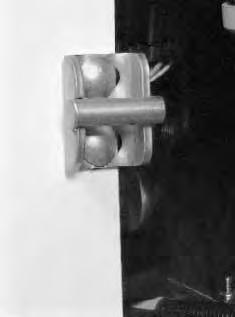
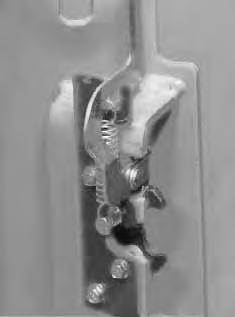
Close the rear door before operating the loader.

Rear Grill
Open the rear door.
Raise the rear grill [A].
The rear grill is held open by the cylinder (Item 1) [B] on the right side of the rear grill.

Lower the rear grill and close the rear door before operating the loader.









